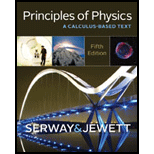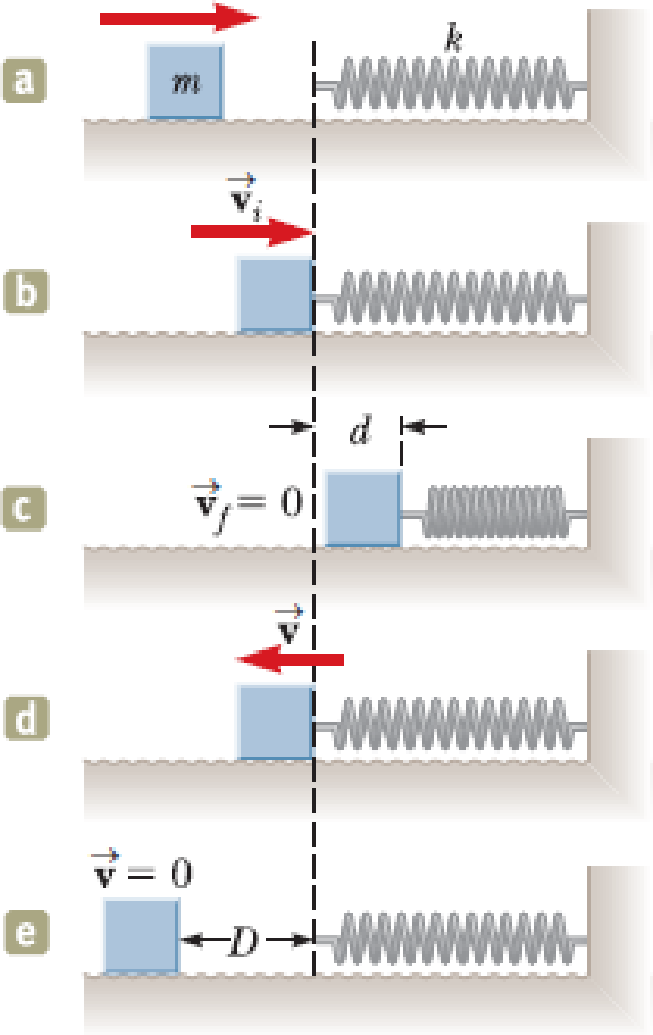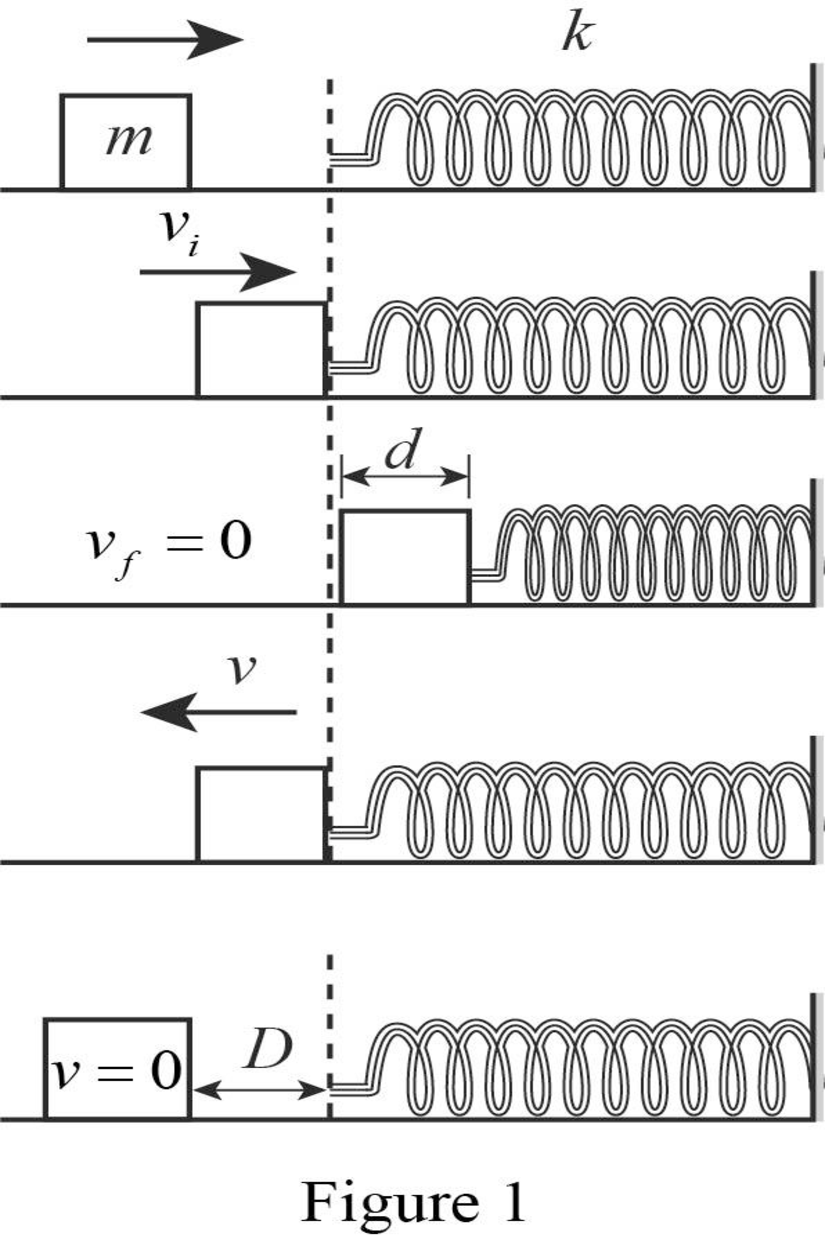
Concept explainers
A 1.00-kg object slides to the right on a surface having a coefficient of kinetic friction 0.250 (Fig. P7.68a). The object has a speed of vi = 3.00 m/s when it makes contact with a light spring (Fig. P7.68b) that has a force constant of 50.0 N/m. The object comes to rest after the spring has been compressed a distance d (Fig. P7.68c). The object is then forced toward the left by the spring (Fig. P7.68d) and continues to move in that direction beyond the spring’s unstretched position. Finally, the object comes to rest a distance D to the left of the unstretched spring (Fig. P7.68e). Find (a) the distance of compression d, (b) the speed v at the unstretched position when the object is moving to the left (Fig. P7.68d), and (c) the distance D where the object comes to rest.
Figure P7.68

(a)
Distance of compression.
Answer to Problem 68P
The distance of compression is
Explanation of Solution

Write the energy conservation equation between second and third picture.
Here
Write the equation for change in kinetic energy,
Here
Write the equation for change in potential energy,
Here
The final kinetic energy zero as the final velocity zero. The initial elastic potential energy is also zero as the spring is not extended initially.
Write the equation for change in internal energy
Here
Substitute (II), (III) and (IV) in (I)
Conclusion:
Substitute
Then,
The distance of compression is
(b)
Speed at the un stretched position when the object is moving left.
Answer to Problem 68P
The speed is
Explanation of Solution
Write the energy conservation equation between picture two and four
Substitute (II) and (IV) in (VI)
Substitute
Rewrite (VIII) for
Conclusion:
Substitute
The speed is
(c)
The distance at which the object comes to rest.
Answer to Problem 68P
The distance is
Explanation of Solution
Consider the motion from picture two to five
Substitute
Rearrange (X) in terms of
Conclusion:
Substitute
The distance is
Want to see more full solutions like this?
Chapter 7 Solutions
Principles of Physics
- An inclined plane of angle = 20.0 has a spring of force constant k = 500 N/m fastened securely at the bottom so that the spring is parallel to the surface as shown in Figure P6.61. A block of mass m = 2.50 kg is placed on the plane at a distance d = 0.300 m from the spring. From this position, the block is projected downward toward the spring with speed v = 0.750 m/s. By what distance is the spring compressed when the block momentarily comes to rest?arrow_forwardA block of mass m = 2.00 kg is attached to a spring of force constant k = 500 N/m as shown in Figure P7.15. The block is pulled to a position xi = 5.00 cm to the right of equilibrium and released from rest. Find the speed the block has as it passes through equilibrium if (a) the horizontal surface is frictionless and (b) the coefficient of friction between block and surface is k = 0.350. Figure P7.15arrow_forwardA 1.00-kg object slides to the right on a surface having a coefficient of kinetic friction 0.250 (Fig. P8.62a). The object has a speed of vi = 3.00 m/s when it makes contact with a light spring (Fig. P8.62b) that has a force constant of 50.0 N/m. The object comes to rest after the spring has been compressed a distance d (Fig. P8.62c). The object is then forced toward the left by the spring (Fig. P8.62d) and continues to move in that direction beyond the spring's unstretched position. Finally, the object comes to rest a distance D to the left of the unstretched spring (Fig. P8.62e). Find (a) the distance of compression d, (b) the speed vat the unstretched posi-tion when the object is moving to the left (Fig. P8.624), and (c) the distance D where the abject comes to rest. Figure P8.62arrow_forward
- A horizontal spring attached to a wall has a force constant of k = 850 N/m. A block of mass m = 1.00 kg is attached to the spring and rests on a frictionless, horizontal surface as in Figure P7.55. (a) The block is pulled to a position xi = 6.00 cm from equilibrium and released. Find the elastic potential energy stored in the spring when the block is 6.00 cm from equilibrium and when the block passes through equilibrium. (b) Find the speed of the block as it passes through the equilibrium point. (c) What is the speed of the block when it is at a position xi/2 = 3.00 cm? (d) Why isnt the answer to part (c) half the answer to part (b)? Figure P7.55arrow_forwardA 6 000-kg freight car rolls along rails with negligible friction. The car is brought to rest by a combination of two coiled springs as illustrated in Figure P6.27 (page 188). Both springs are described by Hookes law and have spring constants k1 = 1 600 N/m and k2, = 3 400 N/m. After the first spring compresses a distance of 30.0 cm, the second spring acts with the first to increase the force as additional compression occurs as shown in the graph. The car comes to rest 50.0 cm after first contacting the two-spring system. Find the cars initial speed.arrow_forwardConsider the data for a block of mass m = 0.250 kg given in Table P16.59. Friction is negligible. a. What is the mechanical energy of the blockspring system? b. Write expressions for the kinetic and potential energies as functions of time. c. Plot the kinetic energy, potential energy, and mechanical energy as functions of time on the same set of axes. Problems 5965 are grouped. 59. G Table P16.59 gives the position of a block connected to a horizontal spring at several times. Sketch a motion diagram for the block. Table P16.59arrow_forward
- Review. This problem extends the reasoning of Problem 41 in Chapter 9. Two gliders are set in motion on an air track. Glider 1 has mass m1 = 0.240 kg and moves to the right with speed 0.740 m/s. It will have a rear-end collision with glider 2, of mass m2 = 0.360 kg, which initially moves to the right with speed 0.120 m/s. A light spring of force constant 45.0 N/m is attached to the back end of glider 2 as shown in Figure P9.41. When glider 1 touches the spring, superglue instantly and permanently makes it stick to its end of the spring. (a) Find the common speed the two gliders have when the spring is at maximum compression. (b) Find the maximum spring compression distance. The motion after the gliders become attached consists of a combination of (1) the constant-velocity motion of the center of mass of the two-glider system found in part (a) and (2) simple harmonic motion of the gliders relative to the center of mass. (c) Find the energy of the center-of-mass motion. (d) Find the energy of the oscillation.arrow_forwardIn a laboratory experiment, 1 a block of mass M is placed on a frictionless table at the end of a relaxed spring of spring constant k. 2 The spring is compressed a distance x0 and 3 a small ball of mass m is launched into the block as shown in Figure P11.22. The ball and block stick together and are projected off the table of height h. Find an expression for the horizontal displacement of the ballblock system from the end of the table until it hits the floor in terms of the parameters given. FIGURE P11.22arrow_forwardA 4.00-kg particle moves along the x axis. Its position O varies with time according to x = t + 2.0t3, where x is in meters and t is in seconds. Find (a) the kinetic energy of the particle at any time t (b) the acceleration of the particle and the force acting on it at time t, (c) the power being delivered to the particle at time t and (d) the work done on the particle in the interval t = 0 to t = 2.00 s.arrow_forward
- A childs pogo stick (Fig. P7.69) stores energy in a spring with a force constant of 2.50 104 N/m. At position (x = 0.100 m), the spring compression is a maximum and the child is momentarily at rest. At position (x = 0), the spring is relaxed and the child is moving upward. At position , the child is again momentarily at rest at the top of the jump. The combined mass of child and pogo stick is 25.0 kg. Although the boy must lean forward to remain balanced, the angle is small, so lets assume the pogo stick is vertical. Also assume the boy does not bend his legs during the motion. (a) Calculate the total energy of the childstickEarth system, taking both gravitational and elastic potential energies as zero for x = 0. (b) Determine x. (c) Calculate the speed of the child at x = 0. (d) Determine the value of x for which the kinetic energy of the system is a maximum. (e) Calculate the childs maximum upward speed. Figure P7.69arrow_forwardA ball of mass m = 1.80 kg is released from rest at a height h = 65.0 cm above a light vertical spring of force constant k as in Figure P5.64a. The ball strikes the top of the spring and compresses it a distance d = 9.00 cm as in Figure P5.64b. Neglecting any energy losses during the collision, find (a) the speed of the hall just as it touches the spring and (b) the force constant of the spring.arrow_forward
 Physics for Scientists and Engineers, Technology ...PhysicsISBN:9781305116399Author:Raymond A. Serway, John W. JewettPublisher:Cengage Learning
Physics for Scientists and Engineers, Technology ...PhysicsISBN:9781305116399Author:Raymond A. Serway, John W. JewettPublisher:Cengage Learning Physics for Scientists and Engineers: Foundations...PhysicsISBN:9781133939146Author:Katz, Debora M.Publisher:Cengage Learning
Physics for Scientists and Engineers: Foundations...PhysicsISBN:9781133939146Author:Katz, Debora M.Publisher:Cengage Learning Physics for Scientists and EngineersPhysicsISBN:9781337553278Author:Raymond A. Serway, John W. JewettPublisher:Cengage Learning
Physics for Scientists and EngineersPhysicsISBN:9781337553278Author:Raymond A. Serway, John W. JewettPublisher:Cengage Learning Physics for Scientists and Engineers with Modern ...PhysicsISBN:9781337553292Author:Raymond A. Serway, John W. JewettPublisher:Cengage Learning
Physics for Scientists and Engineers with Modern ...PhysicsISBN:9781337553292Author:Raymond A. Serway, John W. JewettPublisher:Cengage Learning Principles of Physics: A Calculus-Based TextPhysicsISBN:9781133104261Author:Raymond A. Serway, John W. JewettPublisher:Cengage Learning
Principles of Physics: A Calculus-Based TextPhysicsISBN:9781133104261Author:Raymond A. Serway, John W. JewettPublisher:Cengage Learning College PhysicsPhysicsISBN:9781305952300Author:Raymond A. Serway, Chris VuillePublisher:Cengage Learning
College PhysicsPhysicsISBN:9781305952300Author:Raymond A. Serway, Chris VuillePublisher:Cengage Learning





